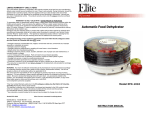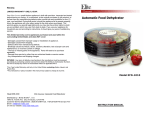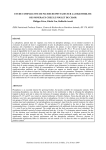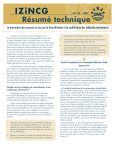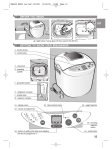Download Ronco 5-Tray Instructions and Recipes
Transcript
TM Turbo 5-Tray Dehydrator Instructions & Recipe Booklet Table of Contents Important Safeguards......................................................................... 2 Cleaning Instructions .......................................................................... 3 Tray Setup and Storage ..................................................................... 3 The Finer Points of Dehydration........................................................ 4 Quick Start – Dehydrating Basics...................................................... 5 How to Dehydrate and Succeed...................................................... 6 Pretreating ........................................................................................... 7 Packing and Storing ............................................................................9 Rehydrating . ........................................................................................ 9 Hints and Reminders......................................................................... 10 Using Dried or Rehydrated Foods ................................................. 12 Drying Temperatures and Tables ................................................... 13 Drying Fruits ....................................................................................... 13 Drying Vegetables . ........................................................................... 14 Drying Herbs....................................................................................... 15 Drying Jerky ....................................................................................... 18 Fruit Recipes....................................................................................... 19 Vegetable Recipes . ......................................................................... 25 Jerky Recipes .................................................................................... 31 Arts and Crafts ................................................................................ 35 How to Eat Like the Vikings ........................................................... 39 Important Notice and Warranty ..................................................... 40 1 IMPORTANT SAFEGUARDS THIS PRODUCT IS FOR INTENDED FOR HOUSEHOLD USE ONLY When using electrical appliances, basic safety precautions should always be followed. 1. Read all instructions and keep them for future reference. 2. Close supervision is necessary when any appliance is used by or near children. 3. Do not touch hot surfaces. 4. To protect against electrical shock, do not immerse power unit or any part of the dehydrator cord and plug in water or other liquid. 5. Unplug dehydrator when not in use and before cleaning. Allow dehydrator to cool before collapsing for storage. 6. Do not operate any appliance with a damaged cord or plug, or if the dehydrator has been damaged in any manner. 7. The use of accessory attachments not recommended by Ronco may cause injuries. 8. Do not use sharp utensils inside the dehydrator. 9. Do not let cord hang over edge of table or counter or touch hot surfaces. 10. Not for outdoor use. Always dehydrate indoors on a flat surface to allow proper air flow. Do not place on carpet, towel, newspaper, or anything that could block airflow to the bottom base and cause failure. Do not cover the unit with anything. 11. Do not place on or near hot gas or electric burner or in a heated oven. 12. Do not use this appliance for other than its intended use. 13. Be sure the control is in the “OFF” position before unplugging the dehydrator. 14. Before dehydrating, remove excess liquid by patting the ingredients dry. Avoid dripping any water or liquid onto the electrical parts. 15a. To avoid risk of injury resulting from becoming entangled in or tripping over a longer cord, use a short extension cord only when needed. 15b. If a longer extension cord is required, extra caution should be used. 15c. If a longer extension cord is required, please note the following items: - The marked electrical rating of the extension cord should be at least as great as the electrical rating of the appliance, and - The cord should be arranged so it will not hang over the countertop or tabletop where it can be pulled on by children or tripped over unintentionally. 16. Product is not a toy. It is intended for use by capable adults. Adult supervision is required when being used by children. 17. Dehydrator is not to be used with timers or remote control devices. 2 SAVE THESE INSTRUCTIONS NOTE: This appliance has a polarized plug (one blade wider than the other). To reduce risk of electrical shock this plug will fit on a polarized outlet only one way. If the plug does not fit into the outlet, reverse the plug. If it still does not fit, contact an electrician. Do not attempt to defeat this safety feature. CLEANING INSTRUCTIONS TRAYS - To clean your dehydrator trays, soak them in a solution of warm water and mild detergent. Use a soft bristled brush to remove remaining food particles. Do not use sharp utensils, scouring pads or abrasive cleaners. The trays can be washed on the top rack of your dishwasher on low heat. BASE - Make sure that the dehydrator is unplugged before cleaning. Use a damp soft cloth or towel to remove any dried food from the power head unit. Avoid dripping any water or other liquid onto electrical parts. CAUTION: DO NOT IMMERSE POWER UNIT IN WATER OR OTHER LIQUID! DO NOT REMOVE ANY PARTS FROM THE POWER HEAD UNIT. TRAY SETUP AND STORAGE The trays can stack in 2 different positions—one for use and one for storage. Out of the box the trays will be in the Storage Position (see below). To ready the trays for use, each tray (except the bottom one) must be individually rotated 90° in either direction with respect to the tray beneath it. Each tray will sit higher when they are in position to dehydrate food. For easy storage, just rotate each tray 90° in either direction again until all trays are sitting in their lower position. When ready for use, the trays sit higher creating more space for your food. STORAGE POSITION READY FOR USE 3 easy Just slice, dry and store. The prep work is minimal and the “cooking“ is hands-free. The Finer Points of Dehydration The first step in beginning the process of dehydration is to know what dehydration is. Dehydrating is the process of heating food to evaporate moisture inside the food and then removing the water and vapor that is formed. The second is to know how to keep records of your dehydrated food. This way you’ll develop a system and good pattern of quality food drying. We recommend you record the weight of the food before and after dehydration. By labeling drying times on the storage containers will increase the consistency of the quality of dried food. Once the food is dried and stored, you may use it over a period of time in all the fun recipes and crafts presented in this manual or creations of your own. To obtain a rehydrated state, soak the food in water, and then it is ready to use in all of your favorite recipes. Of course our favorite way to enjoy freshly dehydrated food is to eat it right away as a snack! 4 Dried foods are tasty, nutritious, lightweight, easy to prepare, store and use. • There’s so much variety! Create yummy snacks from strawberry-apple fruit leather, to glazed cinnamon banana chips, beef jerky and more. • The Ronco Dehydrator is so easy to use. The prep work is minimal and the “cooking” is completely hands-free. • Dried foods do not lose nutritional value. You control the ingredients so you know your snacks will be healthy. It is very simple and requires minimal storage space for your food; which leaves room for even more dried foods! The best part about it though is, home dehydration saves a lot of money. Quick start - Dehydrating basics Sort & Wash Trim & Cut into Pieces Treat (if necessary) Place on Trays Dehydrate Eat or Pack, Label & Store Important Tips: • Slice most foods thin: 1/8”-1/4” • Do not overlap food on the trays • Make sure to dry at the proper temperature setting • Place goods in air-tight containers 5 en go g reca lly Preserve lo and grown produce n, ow gr me ho bring back s od fo s deliciou hen. into your kitc How to Succeed at dehydrating The fruits and vegetables you are about to use for dehydration should be fresh and fully ripe. We recommend organic produce whenever possible. Wilted, immature, or over-ripe produce will make a dissatisfactory dried product. To prepare your produce for dehydration, you should wash all fresh food thoroughly to remove any dirt or chemicals. Also make sure not to use any food with decay, bruises, or mold, because it may affect the entire batch of food. Don’t forget to peel, pit, or core some fruits and vegetables. Smaller pieces tend to dry faster and more evenly. Before dehydrating, remove excess liquid by patting the ingredients dry. Avoid dripping any water or liquid onto the electrical parts. You should monitor the final stages of dehydration to ensure the food is not over dried. Food should be dry enough to prevent bacterial growth and spoilage. If the food is over dried then it loses quality in taste, texture, and nutrition. Before testing for dryness, take out a piece and let it cool then feel for dryness. 1. Fruits should not have any spots of moisture, and should be leathery. Another test is to tear the piece in half and then watch for drops of moisture where you store it. If there is no moisture then the fruit is read for storage. 2. Vegetables should be brittle. 3. Jerky should be tough. 6 Pretreating Blanching or covering completely in boiling water for a short period of time brings out the enzymes in fruit and vegetables. These enzymes are the reason for color and flavor changes during ripening. Color changes will continue during the drying process unless the produce is pretreated. Blanching also helps set color and dry faster by relaxing the tissues within the produce, keeping the flavors during storage, and improve rehydrating conditions. Many of the lighter colored fruits such as apples, apricots, peaches, nectarines, and pears, tend to darken during drying and storage. To prevent this, the fruit may be dipped and pretreated. Recommended Dips for Pretreating Fruits and Vegetables: 1. Lemon or pineapple juice is a natural alternative to reduce unwanted color or browning. Place sliced fruit into juice, removing it after 1-2 minutes and then arrange in trays. For variety you can add Jell-O powders, lime or orange juice, honey or sprinkle with cinnamon or coconut flakes. 2. Sodium Bisulfite: Be sure to ask a pharmacist for food safe (USP) grade only. Dissolve 1 teaspoon of sodium bisulfite in a quart of water. This helps prevent any loss of vitamins. Prepare small amounts of fruit and dip into the solution for 1-2 minutes. 3. Salt can be used as a solution for dipping. 4. Citric Acid or Ascorbic Acid solutions give a tart taste not unlike that of Vitamin C. These anti-oxidant granules are available at health food and drug stores. Mix about 6 tablespoons in a pint of water, dip for 1-2 minutes, and dry. Great for banana chips and apple rings. 5. Water or Steam Blanching: Fruits with tough skin such as grapes, prunes and small dark plums, cherries, figs, and some berries, may be water-blanched to crack the skins. This allows moisture inside to escape more readily during drying. 6. Syrup Blanching may help retain the color in light colored fruits. It also makes sweetened candied foods. 7 Remember to remove any excess moisture before drying pretreated food by placing the food on paper towels or clean cloths. Trays should be loaded with a thin layer of food as directed. If needed, a clean cheesecloth can be spread on the trays to prevent food pieces from sticking or falling through. For best results, the food being dried should be between 1/8”-1/4” thick and should not exceed roughly 3/4 of each tray’s surface area. healt hy Make nutritious snacks from 100% natural ingredients with no additives or preservatives! 8 Packing and Storing 1. Fruits cut into a wide range of sizes should be allowed to equalize the remaining moisture among the pieces for a week after drying, before placing in long term storage. To do this, place fruit in non-aluminum, non-plastic container and put in a dry, well-ventilated area. 2. Dried foods should be thoroughly cooled before packing. Package in small amounts so food can be used soon after opening. 3. Pack food without crushing, into clean, dry, insect-proof containers. 4. Glass jars or resealable plastic freezer bags make good containers. Metal cans with fitted lids, can be used if the dried food is first placed in a plastic bag. 5. Store in areas that are cool, dry, and dark for longer lasting good quality dried foods. Temperatures for storage should not go any higher than 60 degrees Fahrenheit. 6. Dehydrated food should be checked about once a month, for mold. If mold is found on a piece of the dried food, scrape it off and pasteurize the contents. 7. To pasteurize, spread food on a cookie sheet and bake in an oven for 15 minutes at 175 degrees Fahrenheit. Then repack in a clean, air-tight container. Rehydrating Not all dehydrated food need to be rehydrated. While some fruits are preferred in their dried form, most vegetables are not, and are better when rehydrated. To rehydrate vegetables for cooking, simply wash the product in clean water, then place in unsalted, cold water and cover, letting it soak for 2-8 hours. If possible, cook in the same water used for soaking, adding more water if necessary. It conserves nutritional value. To rehydrate foods like carrots, soak in ice water or water in the refrigerator. Dried foods can be rehydrated by soaking, cooking, or a combination of both. They will resemble their fresh counterparts after rehydration. Although they will resemble 9 fresh fruits in many aspects, dried foods are unique and should not be expected to be exactly like a fresh fruit. Remember; drying does not render the food free of bacteria, yeasts, and mold. It just makes them inactive. Spoiling may occur if soaking is prolonged at room temperature. Make sure to refrigerate if soaking for longer than 1-2 hours. For most vegetables, barely cover them with cold water and soak 20 minutes to 2 hours to replace the moisture. To cook, bring vegetables to a boil and simmer until done. One cup of dried vegetables rehydrates to about 2 cups. For greens cover them with boiling water. For dried fruit, barely cover them with cold water and soak 1-8 hours to replace the moisture depending on fruit type, size of pieces, and water temperature. Hot water takes less time. Over-soaking will produce less flavor. To cook rehydrated fruit, cover and simmer in the same water as was soaked in. One cup of dried fruit rehydrates to about 1 1/2 cups. For greens cover them with boiling water. For maximum nutritional value: 1. Blanch for the correct length of time 2. Pack dried foods properly and store in a cool, dark, dry place 3. Check dried foods periodically to see that moisture has not been absorbed 4. Eat dried foods as soon as possible 5. Use the remaining liquid after rehydration in recipes Hints and Reminders 1. Select ripe produce that is in good condition. Bad food may give an off-flavor to the entire lot. 2. Wash thoroughly to remove dirt or chemicals, remove soft or spoiled areas. Slice and pretreat if necessary. 10 3. Slices should be between 1/8”-1/4” for efficient drying. 4. Drying times will vary according to the size of the load, thickness of the sliced produce, humidity of the air, and the moisture content of the food itself. 5. To test for dryness let the product cool, and then cut a piece open. There should be no visible moisture inside. 6. Fruits tend to dry leathery, and vegetables dry brittle. 7. The presence of natural juices in foods, especially fruits, will vary. 8. Some fruit sugars tend to be stickier than others. 9. Trays may be loaded with foods barely touching, but not overlapping. 10. About 6% to 10% of the moisture may remain in foods without danger of spoilage. 11. Many dried foods will have a leathery consistency similar to licorice. 12. Blanching is advisable for vegetables to inactivate the natural enzymes responsible for undesirable color changes. It also makes dehydration and rehydration go faster. In some cases blanching is used to crack the skins of fruits to allow moisture to escape. 13. When correctly dried, most of your fruits and vegetables will be soft and pliable, without any damp spots. 14. To remove seeds or pits from prunes, grapes, cherries, etc., dehydrate about halfway- then pop seeds out. This prevents juice from dripping out. 15. The Dehydrator has lid vents and base vents in order to maintain circulation while dehydrating. Do not operate with lid or bottom vent blocked at any time. This will interfere with proper airflow. 16. Occasionally check to see if your food is dehydrated. The drying times in this manual are general and depend on many variables. For accurate times, check often and keep records of your own drying experiences. 17. For even drying, you may need to turn your trays 180 degrees every so often. 18. Do not use oil sprays on the trays. 11 Most Important The Food Dehydrator has two vents (lid vents and base vents) in order to maintain proper circulation while dehydrating. Do not operate with lid or bottom vent blocked at any time, as this will interfere with proper airflow. Occasionally check to see if your food is dehydrated. The thickness of your cuts, the moisture content of the food and the relative humidity are all factors in drying. For even drying, you may need to turn your trays 180 degrees every so often. Do not use oil sprays on the trays. economic a l Make your favorite, dried foo ds at hom e at a frac tion of the cost of the grocery s tore. Using Dried or Rehydrated Foods: 12 1 Dried fruit can be used for snacks at home, when you are out and about, and in cookies or other recipes. 2 Serve rehydrated fruits in sauces. You can even include it in your favorite desert recipes. 3 Add dried vegetables to soups, stews, and other dishes. Or serve it as dry snacks or chips served with dip. 4 Rehydrated vegetables can be used in meat pies and other main dishes as well as salads. 5 Powered vegetables go well in broths, raw soups, and salad dressings. Drying TEMPERATURES AND TABLES The times given are approximate. Your drying times will vary with room temperature, humidity, moisture content of the food, how thinly the food is sliced, the number of trays you are using, and personal preference. We recommend keeping records of your own drying experiences as you learn what works best for you. always thoroughly wash food before dehydration Drying Fruits Pretreat if desired and place the fruit into the dehydrator. Optimal drying temperature is 135º F (57º C). Average Drying Time Uses Fruit Preparation Apples After paring, core, slice into rings and dip in pretreatment solution for 2 minutes. Drain and arrange on tray 4-10 hours Applesauce, pies, cobblers, rings, baking and snacks Apricots Dry in halves and turn inside out or cut into quarters. Pre-treat to help retain color. 8-16 hour Baking, granola and snacks Bananas Remove peel, cut into 1/4" slices. 6-12 hours Snacks, baby food, granola and baking Blueberries Wash and remove stems. Blanch until skins crack. 10-18 hours Ice cream, yogurt, granola, snacks and baking Canned Fruit Drain well and slice if necessary. 6-12 hours Baking, granola and snacks Cherries Do not stem until ready to prepare. Pit when 50% dry. Pitting is optional. 18-26 hours Baking, granola and snacks Citrus Fruit Peel (optional), slice 3/8" thick. 6-12 hours Flavorings when powdered Cranberries Wash and remove stems. Blanch until skins crack. 10-18 hours Ice cream, yogurt, granola, snacks and baking Coconut Remove dark outer skin, slice 3/8" thick. 3-8 hours Baking, granola and snacks Figs Remove stems and halve. 8-15 hours Fillings, cakes, puddings, breads and cookies 13 Fruit Preparation Grapes (seedless) Remove stems and place whole grapes on tray. Use parchment paper liners to prevent dripping. Average Drying Time Uses 10-36 hours Raisins; Baking, granola and snacks Kiwi Peel, slice 1/4" to 1/2" thick. 5-12 hours Snacks and granola Lemon Rind Peel in long strips and dry. Do not grate until ready to use. 8-12 hours Zest, seasoning rubs and marinades Mangos Remove skin (optional), slice 3/8" thick from seed. 6-16 hours Baking, granola and snacks Nectarines Halve and remove pit. Cut into 1/4" slices. 6-16 hours Baking, granola and snacks Orange Rind Peel in long strips and dry. Do not grate until ready to use. 8-12 hours Zest, seasoning rubs and marinades Peaches Halve and remove pit. Cut into 1/4" slices. 6-16 hours Baking, granola and snacks Pears Remove core and woody tissue. Cut into slices or rings, halves or quarters. 6-16 hours Baking, granola and snacks Persimmons Use only ripe fruit. Wash, remove cap and cut into 3/8" slices. 6-16 hours Baking, granola and snacks Pineapple Core if fresh, cut into slices, wedges or chunks. Pat dry. 6-12 hours Baking, granola and snacks Plums Halve and remove pit. Cut into 1/4" slices. 8-16 hours Prunes; Baking, granola and snacks Rhubarb Use tender stalks. Wash, slice in 1" lengths. 6-14 hours Pies, tarts and other baked goods Strawberries Halve or slice 1/2" thick. 6-12 hours Baking, granola and snacks Drying Vegetables Most vegetables must be blanched to slow the enzyme action which will continue during drying and storage. Do not blanch onions, garlic, peppers, mushrooms or herbs. Blanching softens the cell structure, allowing moisture to escape and your vegetables will dry more quickly. They will also rehydrate faster. We recommend steam blanching because it helps retain the water-soluble vitamins and nutrients of your vegetables. To steam blanch use a commercial steamer or a stove top steaming rack. Bring 1 inch of water to a boil and drop in your sliced vegetables. 14 Vegetables are done drying when they are crisp, tough or brittle. After cooling, package immediately to prevent absorption of moisture from the air. Drying temperature for vegetables is 130º F to 145º F (55º C to 63º C). Average Drying Time Uses Vegetable Preparation Artichoke Slice hearts into 1/8˝ strips, boil in 3/4 cup water with 1 tbsp lemon juice for 5 to 8 minutes. 6-12 hours Marinate or dip in batter to fry Asparagus Wash and cut into 1" pieces. Blanch. 3-10 hours Rehydrate, serve in cream sauce. Stems crushed after drying to make seasoning. Beans Green/ Wax Remove ends, cut into 1" pieces. Blanch. Stir beans on tray for more even drying. 6-12 hours Stews, soups and casseroles Beets Steam until tender. Cool and peel. Cut into 1/2" pieces. 3-10 hours Soups and stews Broccoli Wash, cut into bite size pieces. Blanch. 4-10 hours Soups, quiche or souffles, cream or cheese sauce Brussels Sprouts Cut sprouts from stalks, cut in half lengthwise through stem. 4-10 hours Marinate or dip in batter to fry Cabbage Trim. Slice into strips 1/8" thick. 4-5 hours Soups and stews Carrots Peel, cut ends, slice 2/8" thick or shred. Blanch. 6-12 hours Salads, soups, stews and carrot cake Cauliflower Wash, cut into bite size pieces. Blanch. 6-14 hours Soups and stews Celery Trim, wash and cut into 1/2" slices. Blanch in solution of 1/2 tsp baking soda to 1 cup water. 3-10 hours Soups, stews, powder for celery salt (add equal parts salt) Corn Remove husk and silk. Blanch. Remove from cob stirring kernels periodically. 6-12 hours Fritters, soups, stews or grind for cornmeal Cucumber Pare and cut into 1/8" slices 6-14 hours Chips with dip Eggplant Peel, slice 1/4" thick. Blanch. 4-14 hours Cream sauces, casseroles, dip in batter and fry Kale Trim tough stems. Blanch. 3-10 hours Stews, soups and casseroles 15 Average Drying Time Uses Vegetable Preparation Mushrooms Clean with soft brush, don't wash. 4-10 hours Rehydrate for soups, meat dishes, omelets or frying Okra Use young pods. Trim and cut into 1/4" circles. 6-12 hours Soups, stews and sauces Onions and Leeks Peel, cut off tops and root ends. Slice 3/8" thick. 6-12 hours Soups, stews and sauces Powder for seasoning salt. Package immediately Parsnips Peel, cut ends, slice 2/8" thick or shred. Blanch. 6-12 hours Salads, soups, stews and carrot cake Peas Shell, wash and blanch. 5-14 hours Soups, stews and mixed vegetables Peppers (Green Remove stem and seeds. Cut and Pimentos) into 1/2" pieces. Powdered red pimentos is Paprika. 5-12 hours Soups, stews, pizza, meat dishes and seasoning Peppers(hot) Always wear rubber gloves to protect your hands. Wash, slice or cut in half. Removes seeds for a milder pepper. 3-20 hours Soups, stews, pizza, meat dishes and seasoning Potatoes Peel (optional) and slices 3/8" thick. Blanch for 5 min or until translucent. Rinse and pat dry. 6-12 hours Stews, soups and casseroles Pumpkin and Hubbard Squash Bake or steam small pieces until tender. Cut into 1-3" strips. Peel and remove pulp. 5-10 hours Breads, chips with dip, soups and casserole (1 week shelf life) Rutabagas Peel, cut ends, slice 1/8" thick or shred. Blanch. 6-12 hours Salads, soups, stews and carrot cake Spinach Trim tough stems. Blanch. 3-10 Hours Stews, soups and casseroles Tomatoes Wash and dip in boiling water to loosen skins (optional), slice 3/8" thick, halve or quarter. 6-12 hours Soups and stews Powder in blender and add water for paste or sauce Turnips Peel, cut ends, slice 1/8" thick or shred. Blanch. 6-12 hours Salads, soups, stews and carrot cake Zucchini Wash, remove ends and slice 3/8" thick or grate. Steam if you plan to rehydrate. 5-10 hours Breads, chips with dip, soups and casserole (1 week shelf life) 16 Drying Herbs Herbs are done drying when they snap and crumble easily. Stems should be brittle and break when bend. Seeds should be brittle and will need additional drying when removed from the seed pod. Drying temperature for herbs should not exceed 90º F to 100º F (35º C to 40º C). Because of their different drying temperatures, we do not recommend that you dry herbs with fruits and vegetables. To preserve freshness, do not powder your herbs until you are ready to use. Average Drying Time Uses Herb Preparation Anise Leaves Rinse in cold water, pat dry. 1-3 hours Soups, stews, sauces and salads Anise Seeds Rinse in hot water, pat dry. 2-5 hours Rehydrate and serve in cream sauce Basil Leaves Clip leaves 3-4" from top where buds appear. Rinse and pat dry. Break veins and stems to aid drying. 20-24 hours Italian and Mediterranean dishes, tomato dishes, meat salads, soups, fish, poultry and egg dishes Caraway Clip entire plant. Dip in boiling water and pat dry. Chili Peppers Rinse, dice and pat dry. 5-12 hours Powder for seasoning Chive Leaves Chop and spread on tray. 20-24 hours Mild onion flavor, use in most recipes Cilantro Leaves Chip, rinse in cold water, pat dry. 20-24 hours Mexican, Chinese and Mediterranean dishes Coriander Seeds Clip entire plant. Dip in boiling water and pat dry. 2-5 hours Sausage, pickling spices, apple and pear dishes 2-5 hours Pork, sauerkraut, rye bread, cheese, vegetables, cookies Cumin Seeds Rinse in cold water, pat dry. 2-5 hours Curries and chili dishes Dill Leaves Rinse in cold water, pat dry. 1-3 hours Salads, vegetables, potato and fish dishes Fennel Rinse in cold water, pat dry. 1-3 hours Salads, soups and stews Fennel Seeds Rinse in cold water, pat dry. 2-5 hours Cakes, cookies, breads Garlic Separate and peel cloves. Cut in half. 6-12 hours Soups, powder for seasoning 17 Average Drying Time Uses Herb Preparation Ginger Leaves Rinse in cold water, pat dry. 1-3 hours Soups Ginger Root Rinse, slice 3/8" or grate, pat dry. 2-6 hours Meat, vegetables, cookies and dessert dishes Marjoram Leaves Rinse in cold water, pat dry. 1-3 hours Italian, meat, fish, egg and poultry dishes Mint Leaves Rinse in cold water, pat dry. 20-24 hours Mustard Seeds Rinse in cold water, pat dry. 2-5 hours Corn beef, sauerkraut, salad dressings and cabbage Oregano Leaves Rinse in cold water, pat dry. 15-18 hours Italian, Greek, Mexican and tomato dishes Parsley Rinse in cold water, pat dry. 20-24 hours Powder, use leaves for flakes Rosemary Leaves Rinse in cold water, pat dry. 20-24 hours Barbecue sauces, poultry, meats, egg dishes, lamb and vegetables Sage Leaves/ Stem Rinse in cold water, pat dry. 20-24 hours Poultry, pork, lamb, veal and fish dishes Tarragon Leaves Rinse in cold water, pat dry. 20-24 hours Sauces, salads, fish and poultry Thyme Leaves Rinse in cold water, pat dry. 1-3 hours Meat, fish, poultry dishes, green beans, beets, carrots and potatoes Sauces, mint jelly & lamb dishes Drying Jerky Jerky can be made using a variety of lean meats, fish and poultry. When making jerky from pork, chicken or turkey, use precooked and processed meat. Be sure to dry meat at the highest temperature. After drying, heat in your oven at a temperature of 165º F (74º C) for 30 minutes to protect against salmonella. When you are drying game meats, freeze the meats for at least 60 days at 0º F(-18º C) before drying to rid the meat of any diseases it might be carrying. Then thaw meat, add seasoning and dry. 18 Fruit Recip es 19 Desserts Spiced Peach Pie Soak 1 1⁄2 cups dried peaches in the refrigerator overnight. Then stew until soft (about 45 minutes). Chop peaches and add a mixture of: 1 1⁄2 tablespoon cinnamon 2 tablespoons flour 1⁄2 cup white or brown sugar 4 tablespoons melted butter 2 tablespoons water 1⁄8 teaspoon salt Add mixture to peaches and stir lightly. Pour into unbaked pie crust, cover with top crust. Bake 35 to 45 minutes until golden brown at 350°F. Makes one 9-inch pie. Apple Pie 2 cups dried apples 1 cup sugar brown or white 1⁄4 teaspoon salt 2 tablespoons flour 1 double pie crust recipe 1 tablespoon butter 1 teaspoon cinnamon 1⁄4 teaspoon allspice 1 tablespoon butter 1⁄4 teaspoon mace Reconstitute apples by adding just enough water to cover the apples. More water can be added if necessary. Soak for about four hours. Over-soaking will produce a loss of flavor. Sift dry ingredients together and mix with the rehydrated apples. Line pie pan with pastry. Fill with apple mixture, dot with butter and cover with top crust. Bake at 450°F 15 minutes; reduce temperature to 350°F and bake 45 minutes longer. Makes one 9-inch pie. 20 Healthy Snacks Glazed Banana Cinnamon Chips Slice Bananas into lemon juice or ascorbic acid. Drain on paper towel. Arrange on tray. Sprinkle with a mixture of sugar and cinnamon. Dry to shiny crispness. Honey Glazed Banana Chips Slice bananas and dip into a glaze of 1/4 cup honey thinned with 1/4 cup water. Drain, place on trays and dry. Dried Candied Fruits Rinse fruits or fruit rinds and cut into thin strips. Simmer slowly in a solution of approximately 2 cups water and 2 cups sugar for 1 1/2 hours. Test for tenderness. Place on trays and dry until pliable. Cool and store in air tight containers. Use for snacks or in cooking. Fruit Compote Combine any or all of the following dried fruits in whatever amounts you desire. Soak overnight or for several hours in enough water to cover. Add honey or sugar if desired, and grated dried lemon or orange peel or a few sticks of clove. Apples Peaches Strawberries Bananas Plums Mangos Apricots Nectarines Kiwi Pineapple Rhubarb 21 FRUITY APPETIZER Brie with Dried Fruit 1 round (8 oz) Brie cheese 3 tablespoons brown sugar 1⁄2 cup dried fruit (cranberries, raisins, apricots) Toasted baguette slices 3 tablespoons maple syrup 1 tablespoon orange liqueur 1/4 cup coarsely chopped pecans, toasted (optional) Heat oven to 350°F. Line cookie sheet with foil. Place cheese on cookie sheet. Bake 10 minutes or until cheese begins to soften. Heat syrup, brown sugar and liqueur in 8-inch sauté pan or skillet, and bring to a boil. Cook until mixture becomes thick and syrupy. Place warm Brie on serving plate. Top with dried fruit and pecans. Pour syrup over top. Serve with baguette slices. Makes 12 servings. 22 Fruit Rollups or Fruit Leather Select fruits such as peaches, strawberries, bananas, apples, etc. Puree with a kitchen blender or food processor and add a little fruit juice. Sweeten to taste with sugar, honey, agave nectar or fruit juice. Pour the puree onto the Ronco Fruit Rollup & Liquid Tray (sold separately). We recommend you use only 1 or 2 trays at a time. For even drying, you may need to turn your trays 180 degrees every so often. Dehydrate for 4-8 hours until fruit feels leather-like and is pliable. Drying times will vary with moisture content and humidity. To release, pull off the cool, dried “Rollup” from the plastic food wrap or the Ronco Fruit Rollup & Liquid Tray and serve. 23 Trail Treats Quick Energy Snacks 4 cups rolled oats 1 cup brown sugar 1 cup dry roasted nuts 1 1⁄2 cups coconut flakes 1 cup chopped dates or dried apricots 1⁄2 cup raisins Mix all ingredients together thoroughly in resealable plastic bags for munching on hikes and camping trips. Homemade Granola Less expensive, tastier and fresher than the store-bought variety - and this granola is fun to make! 5 cups rolled oats 1⁄2 cup wheat germ 1⁄2 cup packed brown sugar 1⁄2 cup honey 1⁄2 cup dried apple, chopped 1⁄2 cup sesame seeds 1 cup raisins 1 teaspoon vanilla 1⁄2 cup chopped dates 1 teaspoon cinnamon 1 cup pecans or almonds, chopped Mix all ingredients together until evenly distributed. Spread out on dehydrator tray lined with cheese cloth or use the Ronco Herb Screen (sold separately). Dry until crispy, then store in an air-tight container or in resealable plastic bags. Great for breakfast, lunches, snack or a topper over ice cream and yogurt. Crispy Nuts and Seeds Soaking and drying nuts and seeds reduces phytic acid and enzyme inhibitors which can prevent absorption of nutrients. Many nuts (walnuts, almonds, etc.) should be soaked overnight in salt water and then dried for 12-24 hours until nice and crispy. Soaked and dried nuts and seeds usually taste better. 24 e l b a t e Veg s e p i c e R 25 Veggies for Dinner Vegetable Soup 2 cups dried beef, diced (optional) 8 cups water 1⁄2 cup diced dried onions Salt & Pepper 1⁄2 cup diced dried carrots 1⁄4 teaspoon sage 2 tablespoons chopped dried parsley 1⁄4 cup dried peas 1 cup dried tomatoes 1⁄2 cup pearl barley 1 cup dried diced potatoes 1⁄2 cup dried chopped celery and crushed celery leaves Put meat and vegetables in soup pot, cover with cold water. Bring almost to a boil, reduce heat and simmer for four to six hours until vegetables are tender. One hour before soup is done add dried diced potatoes. Season to taste. Scalloped Potatoes 4 cups dried, sliced potatoes 1 cup milk 2 cups boiling water 1⁄2 teaspoon salt 1⁄2 teaspoon dried onion 1 teaspoon butter 1 1⁄2 cups grated cheddar or mozzarella cheese Place half the potatoes in well-buttered 8 x 10 baking dish. Top with layer of half the cheese. Cover with remaining potatoes. Add seasonings to milk and pour over layered potatoes and cheese combination. Dot with butter and top with remaining cheese. Bake at 350°F until tender. 26 Salad Spikers Combine the following dehydrated vegetables: 1⁄2 cup onions 1⁄2 cup carrots 1⁄2 cup tomatoes 1⁄2 cup bell pepper When they are dry and crunchy, chop into tiny pieces and add: 1⁄4 cup roasted sunflower seeds and 1 tablespoon of basil or oregano. Mix thoroughly and sprinkle about 1 teaspoonful on salads. Add your favorite salad dressing and toss. Store unused portion in refrigerator to preserve crispness. Creative Crackers & Chips Jalapeno Corn Chips 3 cups fresh or frozen (defrosted) corn 1 jalapeno pepper 1 teaspoon salt, to taste Remove seeds and ribs from jalapeno and chop. Puree corn in food processor, adding water as needed to create an oatmeal consistency. Add in salt and jalapeno and puree until well blended. Spread thinly (1/8 - 1/4” thick) onto the Ronco Fruit Rollup & Liquid Tray (sold separately) and put in your dehydrator until crispy, flipping once about halfway through dry time (about 8 - 12 hours). Zucchini Chippers Before drying, sprinkle zucchini slices lightly with sesame seeds and garlic salt. Serve plain as a nutritious snack or with a dip or ranch dressing. 27 Vegetable Crackers 1 cup flax seeds 2 medium tomatoes 2 carrots 2 cloves garlic 1 teaspoon dill seed 1 teaspoon cumin 3 cups water 1/2 medium onion 2 celery stalks 2 teaspoons basil 1 teaspoon sea salt Place the flax seeds in water. Allow to soak overnight. In a food processor, use a setting. Grate the tomatoes, onion, celery, carrots and garlic. Add the basil, dill seed, sea salt and cumin. Switch to the regular setting on the food processor and blend ingredients, adding enough water to create a smooth mixture. Combine vegetable mixture and flax seeds in a large mixing bowl. At this point, the mixture should have a mild taste. The flavors will become more intense as the crackers dehydrate. Using a tablespoon, drop spoonfuls of the vegetable mixture dehydrator sheets. Dehydrate for approximately 12 hours, or until the crackers turn easily and have reached your desired level of crispiness. Raw Kale Chips 1 Bunch Kale Sea Salt Juice of Half a Lemon Olive oil Diced Garlic Pinch of Cumin Wash the kale and then cut it into 3 inch long strips. Put the sliced kale in a large bowl and add the olive oil, sea salt, diced garlic, lemon juice, and cumin, all to taste. Use your hands to massage the ingredients into the kale. Wait for 10 to 20 minutes: the kale leaves should have shrunk a little bit. Now place your marinated kale on a dehydrator tray and turn the dehydrator on to dry for about 7 to 8 hours. 28 Baby Food Make nutritious baby food without preservative, stabilizers or additives by using any vegetables or fruits you have previously dehydrated. Simply soak any amount of the produce in an equal amount of warm water. Steam for a few minutes and mash with a fork or puree in blender or food processor. Instant Baby Food You can also make instant baby food with your dehydrator by cooking your vegetables first. Cook or steam your desired vegetable until soft. Use a food processor to make a puree and then dehydrate until they are crispy and brittle. Next, use your food processor or blender and blend until it becomes a fine powder. To reconstitute, heat up 1/8 cup water and add 1 1/2 teaspoons of the vegetable powder to it. Let sit for 1-2 minutes so that it becomes soft. Check the consistency. If it is too thick or concentrated just add a little more water until you reach your desired consistency. 29 Herbs Most herbs dry overnight. You will have about one pound of dry herbs for every eight pounds of fresh herbs. Dried herbs retain their flavor best if they are crushed just before using. Home dehydration saves a lot of money. You can dry almost any herb you can find including dry chives, oregano, basil, dill, rosemary, thyme, parsley, mint, and peppers. Herb Teas Many of your garden herbs can be dried in your Food Dehydrator and stored in air-tight containers for use throughout the year to make delicious, healthful herb teas. Use the leaves and flowers (but not the course stems) of most herbs like chamomile, mint, strawberry, sage, blackberry, blueberry and others. It is simple and economical with the Food Dehydrator. Just steep the dried leaves in a teapot and strain. 30 J erky Recipes 31 Jerky Recipes Normally raw meat is used for jerky. However, cooked meat as well as raw meat may be dehydrated for later rehydration. Cut meat to size for recipes before dehydration. You’ll find that meat is much easier to work with when its cut to size before it is dehydrated and becomes crispy. USE CAUTION when making jerky from raw chicken or turkey due to food borne bacteria, like salmonella, that may be present in the poultry when you purchase it. It is extremely important that both raw chicken and turkey not exceed 1/4” thickness. Marinade must thoroughly soak into the meat (soak for 10 minutes). Do not pat dry or remove any of the marinade sauce. Make absolutely sure that you follow all instructions precisely. Do not consume any food that tastes, smells, or looks improper, especially jerky. Wash hands and utensils well. It is also recommended that raw meat be boiled/blanched at 160 degrees Fahrenheit. Raw Meat for Beef Jerky: Any kind of beef is good for making Beef Jerky. The secret is to trim off all of the fat before slicing. In many cases, your local supermarket butcher will slice the selected meat for you free of charge. We suggest meat be sliced about 1/8”-1/4” thick. If meat is slightly thicker, increase the marinating time. Marinate using the recipe below, or one of our Ronco Jerky Marinades. Marinate the meat for 5-10 minutes. Thicker cuts of meat will need to marinate considerably longer. It is important that the marinade soak into the meat thoroughly. Place one layer of meat on each tray. If you like slightly thicker slices then increase the drying time accordingly. Store in clean jars with tight lid or use resealable plastic storage bags. 32 Marinade For Beef, Fish or Turkey Jerky Makes enough for 4 pounds of meat. 1/2 lb brown sugar Spices of your choosing 3 cups soy sauce 1⁄4 cup liquid smoke Mix ingredients in bowl and let stand while you are cutting the meat. Place beef, fish or turkey into the bowl of marinade, secure lid and let stand about 10 minutes. Shake bowl and turn bowl every few minutes to cover all pieces equally. Drain in sieve or colander. Place on trays and dehydrate. For even drying, you may need to turn your trays 180 degrees every so often. Drying time is about 4-15 hours, depending on the thickness of the slices and humidity. Chinese Jerky Marinade 1/4 cup light soy sauce 2 1/4 tbsp dry sherry 3/4 tbsp ginger, minced 3/4 tbsp red pepper, crushed 2 1/4 tbsp honey 3 cloves garlic, minced 3/4 tbsp sesame oil Dash white pepper Combine ingredients and rub thoroughly into meat. Marinade overnight. Drain in sieve or colander. Place on trays and dehydrate. For even drying, you may need to turn your trays 180 degrees every so often. Drying time is about 4-15 hours, depending on the thickness of the slices and humidity. 33 Hot & Tangy Jerky Marinade 1 tsp salt 1/4 tsp cayenne pepper 2 cloves crushed garlic 3 tbsp worcestershire sauce 1/4 tsp cracked pepper 1 tsp onion powder 2 tbsp steak sauce 1/2 tsp paprika Combine ingredients and rub thoroughly into meat. Marinade overnight. Drain in sieve or colander. Place on trays and dehydrate. For even drying, you may need to turn your trays 180 degrees every so often. Drying time is about 4-15 hours, depending on the thickness of the slices and humidity. Hawaiian Jerky Marinade 1 tsp salt 1 tbsp brown sugar 1/8 tsp cayenne pepper 1/4 cup pineapple juice 1 tsp ground ginger 1/4 tsp pepper 1 crushed garlic clove 1/4 cup soy sauce Combine ingredients and rub thoroughly into meat. Marinade overnight. Drain in sieve or colander. Place on trays and dehydrate. For even drying, you may need to turn your trays 180 degrees every so often. Drying time is about 4-15 hours, depending on the thickness of the slices and humidity. 34 & s t r A s t f a r C 35 Arts and Crafts Turn your dehydrator into family fun. You can get creative and make fun decorations, gifts for Mother’s Day & Father’s Day and Holiday ornaments. Great fun on any rainy day. Here’s a handful of ideas to get you started: • Wreaths • Napkin Rings • Photo Frames • Christmas Trim • Ornaments • Fun Jewelry • Dolls • Figurines • Centerpieces • Name Tags • Candle Holders • Child Hand Prints • Dog Prints • Magnet Arts • Pins • Toys • Miniatures 36 Food Dehydrator Clay 2 cups flour 1 cup water 1 cup salt Mix flour and salt together, then add water. Blend mixture by hand. Knead by hand 2 or 3 minutes into a pliable, moist ball. Roll dough on a well-floured surface, adding flour to the top of the dough so it will not stick. Keep surface well-floured as you roll and turn dough. Cut into shapes or make figurines and then dry. Holiday Ornaments Roll dough thin - as you would a cookie. Use cookie cutters for designs. Make extra ornaments to use as testers. You’ll break the testers to see if dough is completely dry all the way through. Sprinkle a little flour on the dehydrator trays and place ornaments (not touching each other) on the trays. Dehydrate for 48-60 hours. You really can’t over-dry them. Be sure your testers break with a snap and are completely dry inside. 1. Roll dough as smoothly as possible. 2. Remember not to make ornaments/art too tall. They must fit within the tray height without touching the next tray on the top. 3. Paint with craft paint after dehydrating or color dough with food coloring prior to molding. Clear spray helps preserve your crafts. Mexican Dough Art 2 cups baking soda 1 cup cornstarch 1 1⁄4 cups cold water Combine ingredients in pan. Cook, stirring continuously, for about 5 minutes or until mixture thickens and forms into a ball. Knead by hand until smooth. Form into jewelry, figurines, small sculptures, beads or art. Dry in your food dehydrator and paint, if desired. Finish by spraying with a clear plastic to seal and protect. 37 Sachets And Potpourri Now you can save the beauty of spring and summer and enjoy the sweet-smelling plants you have in your flower and herb garden with the Food Dehydrator all year long. Select petals or small pieces of the flower and place them loosely on the fine mesh tray and place them in your Food Dehydrator. When perfectly dried (about 5 hours) store the petals in decorative containers or sachet bags that close with a ribbon. You can sprinkle the petals with spices such as powdered cinnamon, whole cloves, a bit of dried rosemary or mint for variety. It is best to keep the container closed until all of the fragrances have blended. Then during the winter months the room can have the smell of springtime. A small sachet bag may be placed in your drawers to provide a nice lingering fragrance for years. 38 How to Eat Like the Vikings (A Brief History of Dehydration) Archeologists have discovered that early man sustained himself on natural dehydrated foods. They did this by using the heat from the sun or their fires to preserve food harvested during plentiful seasons. Dried foods have been found in pyramids and other tombs, and even centuries later some of it was still completely preserved! For this reason early civilizations used dehydrated foods on long journeys. The Vikings carried dried foods on their sea voyages, Pilgrims found Native Americans drying food, and pioneers used dried beef jerky and other dried foods as staples on their journeys across the country. And now in our own time, the Astronauts eat dehydrated food up in space because it is lightweight and does not take up that much room. Today, modern society is taking an increased interest in the nutritional value of dehydration. Dehydrating is simple, healthy, green and economical. With the Ronco Dehydrator you still save money, and the process goes much faster than the sun dried method. 39 Important Notice Your Ronco Food Dehydrator has a vent on its top and bottom. Do not operate with top or bottom vent blocked at any time as this will interfere with proper air flow. Do not use oil sprays on the trays. For even drying, you may need to turn your trays 180 degrees every so often. ONE YEAR LIMITED WARRANTY Ronco Holdings, Inc., warrants the original purchaser or owner of this new product that it is free from defects in materials and workmanship for one year from documented date of purchase. We will repair or replace any part of the product, which in our opinion is defective, provided the product has not been abused, misused, altered or damaged after purchase. Use according to directions. This warranty gives you special legal rights and you may have other rights which vary from state to state. Should a defect develop within a year of normal use, you may return it for repair or replacement. For repair or replacements please call Customer Service at 1.855.85.RONCO, or submit a support ticket online at http://ronco.suppport.com. For more information on our Dehydrators, visit us online at www.RoncoDehydrator.com. 40 Ronco Holdings, Inc. 15505 Long Vista Dr., Ste 250 Austin, TX 78728 1.855.85.RONCO www.RoncoDehydrator.com Copyright ©2013 by Ronco Holdings, Inc. All Rights Reserved. Printed in China. 06.12 Food Drying Basics Drying is one of the oldest methods of preserving food and compared with other methods, drying is quite simple. In the beginning, a lot of salt had to be used to preserve foods, and they were dried in the sun. Today we have the Ronco Food Dehydrator to help in the process of drying. Whether you garden, buy from local farmers or are conscious of the high cost of store bought dried products, drying foods at home is easy, nutritious and delicious. Dried foods can be eaten on the spot for snacks or stored to enjoy seasonal foods all year.












































